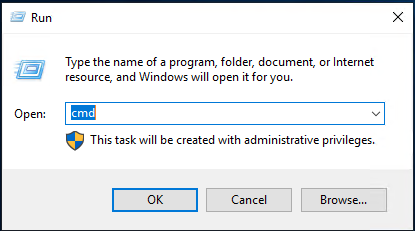The tracert command is a frequently used tool in the monitoring and maintenance of servers. For example, if a client is in Beijing and the cloud server is located in Hong Kong, accessing the server from the client's computer involves passing through routing nodes in Beijing, Shanghai, Guangzhou, and then finally reaching Hong Kong. The tracert command displays the routing nodes encountered along the way, along with the time taken to reach each node. Fewer routing nodes and shorter times indicate a faster network speed from the client to the server.
To perform this test on a Windows operating system, enter 'cmd' in the run dialog to open the command prompt window. Then, type in 'tracert [IP address]' to start the test.

Assuming the cloud server's IP address is 222.35.76.205, the test results would appear as follows:
C:\>tracert 222.35.76.205
Tracing route to 222.35.76.205 over a maximum of 30 hops
1 <1 ms 1 ms 1 ms 10.10.4.1
2 10 ms 9 ms 8 ms bj141-130-114.bjtelecom.net [219.141.130.114]
3 9 ms 8 ms 8 ms 219.142.8.6
4 6 ms 6 ms 7 ms 211.157.37.14
5 10 ms 8 ms 7 ms 222.35.253.130
6 12 ms 10 ms 9 ms 222.35.251.14
7 13 ms * 9 ms 222.35.251.166
8 * * * Request timed out. (The node is operational but is configured to block return values.)
9 9 ms 8 ms 7 ms 222.35.76.205
Trace complete.The following is a hypothetical scenario simulating network line faults, for reference.
C:\>tracert 222.35.76.205
Tracing route to 222.35.76.205 over a maximum of 30 hops
1 <1 ms 1 ms 1 ms 10.10.4.1
2 10 ms 9 ms 8 ms bj141-130-114.bjtelecom.net [219.141.130.114]
3 351 ms 318 ms 498 ms 219.142.8.6 (This indicates that the node is experiencing significant network latency.)
4 287 ms 226 ms 517 ms 211.157.37.14
5 110 ms 298 ms 307 ms 222.35.253.130
6 212 ms 180 ms 179 ms 222.35.251.14
7 135 ms 256 ms * 222.35.251.166
8 * * * Request timed out. ( If the connectivity remains consistently disrupted, it suggests there are issues with this particular node.)
9 * * * Request timed out.
10 * * * Request timed out.
11 * * * Request timed out.23-02-2024 02:02:07
22-02-2024 03:19:32
22-02-2024 03:16:03
22-02-2024 03:14:03
22-02-2024 03:11:58